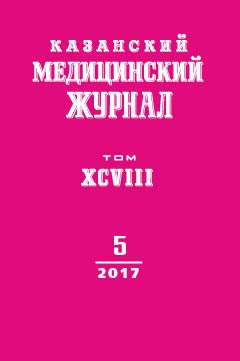Experimental validation of gene therapy for ischemic stroke
- Authors: Sokolov ME1, Bashirov FV1, Safiullov ZZ1
-
Affiliations:
- Kazan State Medical University
- Issue: Vol 98, No 5 (2017)
- Pages: 763-769
- Section: Experimental medicine
- URL: https://kazanmedjournal.ru/kazanmedj/article/view/7032
- DOI: https://doi.org/10.17750/KMJ2017-763
- ID: 7032
Cite item
Full Text
Abstract
Aim. To develop a protocol of direct and cell-mediated gene therapy for ischemic stroke.
Methods. Viral vector carrying green fluorescent protein (GFP) reporter gene was created on the basis of human adenovirus serotype 5 (Ad5). The umbilical blood supply was preserved according to instructions of Kazan State Medical Uuniversity Stem cell bank. Umbilical cord blood mononuclear cells were isolated in a ficoll density gradient by standard procedure and transduced with Ad5-GFP. Ischemic cerebral stroke in rats was caused by distal occlusion of the middle cerebral artery through trephination hole in a temporal bone under surgical microscope. Within four hours after modeling stroke in the anesthetized animals laminectomy was performed at the L4-L5 level, and (1) 0.9% sodium chloride solution, (2) Ad5-GFP and (3) umbilical cord blood mononuclear cells + Ad5-GFP were inserted intrathecally. Survival, targeted migration to the focus of neurodegeneration, the ability to synthesize recombinant protein and the effect of umbilical cord blood mononuclear cells on the infarction area were assessed using luminescent microscopy and morphometric analysis.
Results. GFP expression in the area of the stroke was established 3 weeks after stroke modeling, both after intrathecal insertion of Ad5-GFP and after xenotransplantation of umbilical cord blood mononuclear cells Ad5-GFP transduced ex vivo. When comparing the areas of cerebral infarction 3 weeks after modeling the stroke, in animals from umbilical cord blood mononuclear cells + Ad5-GFP group the median of the infarction area was 47.4% less than in animals receiving isotonic saline solution.
Conclusion. Umbilical cord blood mononuclear cells + Ad5-GFP after intrathecal insertion to animals with ischemic stroke, are capable of targeted migration to the neurodegeneration site as well as of recombinant protein synthesis; the results suggest the expediency of delivering therapeutic genes to ischemic zone via umbilical cord blood mononuclear cells overexpressing neurotrophic factors.
About the authors
M E Sokolov
Kazan State Medical University
Author for correspondence.
Email: supermihon@yandex.ru
Kazan, Russia
F V Bashirov
Kazan State Medical University
Email: supermihon@yandex.ru
Kazan, Russia
Z Z Safiullov
Kazan State Medical University
Email: supermihon@yandex.ru
Kazan, Russia
References
- Китаева Э.А., Китаев М.Р., Суетина Т.А. и др. Внедрение пациентоориентированной программы, направленной на формирование приверженности к лекарственной терапии у пациентов из сельской местности. Вестн. сов. клин. мед. 2017; 10 (2): 64-71. doi: 10.20969/VSKM.2017.10(2).6.
- Китаева Э.А., Китаев М.Р., Саляхова Л.Ю., Вафин А.Ю. Разработка и внедрение программы профилактики острого нарушения мозгового кровообращения на примере Рыбно-Слободского района Республики Татарстан. Казанский мед. ж. 2016; 97 (5): 764-770. doi: 10.17750/KMJ2016-764.
- Rhim T., Lee M. Targeted delivery of growth factors in ischemic stroke animal models. Expert Opin. Drug Deliv. 2016; 13 (5): 709-723. doi: 10.1517/17425247.2016.1144588.
- Craig A.J., Housley G.D. Evaluation of gene therapy as an intervention strategy to treat brain injury from stroke. Front. Mol. Neurosci. 2016; 9: 1-34. doi: 10.3389/fnmol.2016.00034.
- Povysheva T.V., Shmarov M.M., Logunov D.Y. et al. Astrocytes mediated post-traumatic spinal cord regeneration in rats after intraspinal injection of recombinant adenoviral vectors Ad5-VEGF and Ad5-ANG. J. Neurosurg. Spine. 2017; (1): 105-115. doi: 10.3171/2016.9.SPINE15959.
- Islamov R.R., Rizvanov A.A., Mukhamedyarov M.A. et al. Symptomatic improvement, increased life-span and sustained cell homing in amyotrophic lateral sclerosis after transplantation of human umbilical cord blood cells genetically modified with adeno-viral vectors expressing a neuro-protective factor and a neur. Curr. Gene Ther. 2015; 15 (3): 266-276. doi: 10.2174/1566523215666150126122317.
- Lemarchant S., Dunghana H., Pomeshchik Y. et al. Anti-inflammatory effects of ADAMTS-4 in a mouse model of ischemic stroke. Glia. 2016; 64 (9): 1492-1507. doi: 10.1002/glia.23017.
- Niu J., Li C., Wu H. et al. Propidium iodide (PI) stains Nissl bodies and may serve as a quick marker for total neuronal cell count. Acta Histochem. Elsevier GmbH. 2015; 117 (2): 182-187. doi: 10.1016/j.acthis.2014.12.001.
- Rafii M.S. Update on Alzheimer’s disease therapeutics. Rev. Recent Clin. Trials. 2013; 8 (2): 110-118. doi: 10.2174/15748871113089990045.
- Olanow C.W., Bartus R.T., Volpicelli-Daley L.A. et al. Trophic factors for Parkinson’s disease: To live or let die. Mov. Disord. 2015; 30 (13): 1715-1724. doi: 10.1002/mds.26426.
- Jeong H., Yim H., Cho Y. et al. Efficacy and safety of stem cell therapies for patients with stroke: a systematic review and single arm meta-analysis. Int. J. Stem Cells. 2014; 7 (2): 63-69. doi: 10.15283/ijsc.2014.7.2.63.
- Yamashita T., Deguchi K., Nagotani Sh. et al. Gene and stem cell therapy in ischemic stroke. Cell Transplant. 2009; 18 (9): 999-1002. doi: 10.3727/096368909X471233.
- Chen B., Zhang F., Li Q. et al. Protective effect of Ad-VEGF-bone mesenchymal stem cells on cerebral infarction. Turk. Neurosurg. 2016; 26 (1): 8-15. doi: 10.5137/1019-5149.JTN.11488-14.3.
- Karlupia N., Manley N., Prasad K. et al. Intraarterial transplantation of human umbilical cord blood mononuclear cells is more efficacious and safer compared with umbilical cord mesenchymal stromal cells in a rodent stroke model. Stem Cell Res. Ther. 2014; 5 (2): 1-45. doi: 10.1186/scrt434.
- Chernykh E.R., Shevela E.Ya., Starostina N.M. et al. Safety and therapeutic potential of M2 macrophages in stroke treatment. Cell Transplant. 2016; 25 (8): 1461-1471. doi: 10.3727/096368915X690279.
- Sharma A., Sane H., Nagrajan A. et al. Autologous bone marrow mononuclear cells in ischemic cerebrovascular accident paves way for neurorestoration: A case report. Case Rep. Med. 2014; 2014: 1-5. doi: 10.1155/2014/530239.
- Ballen K.K., Gluckman E., Broxmeyer H.E. Umbilical cord blood transplantation: the first 25 years and beyond. Blood. 2013; 122 (4): 491-498. doi: 10.1182/blood-2013-02-453175.
Supplementary files







